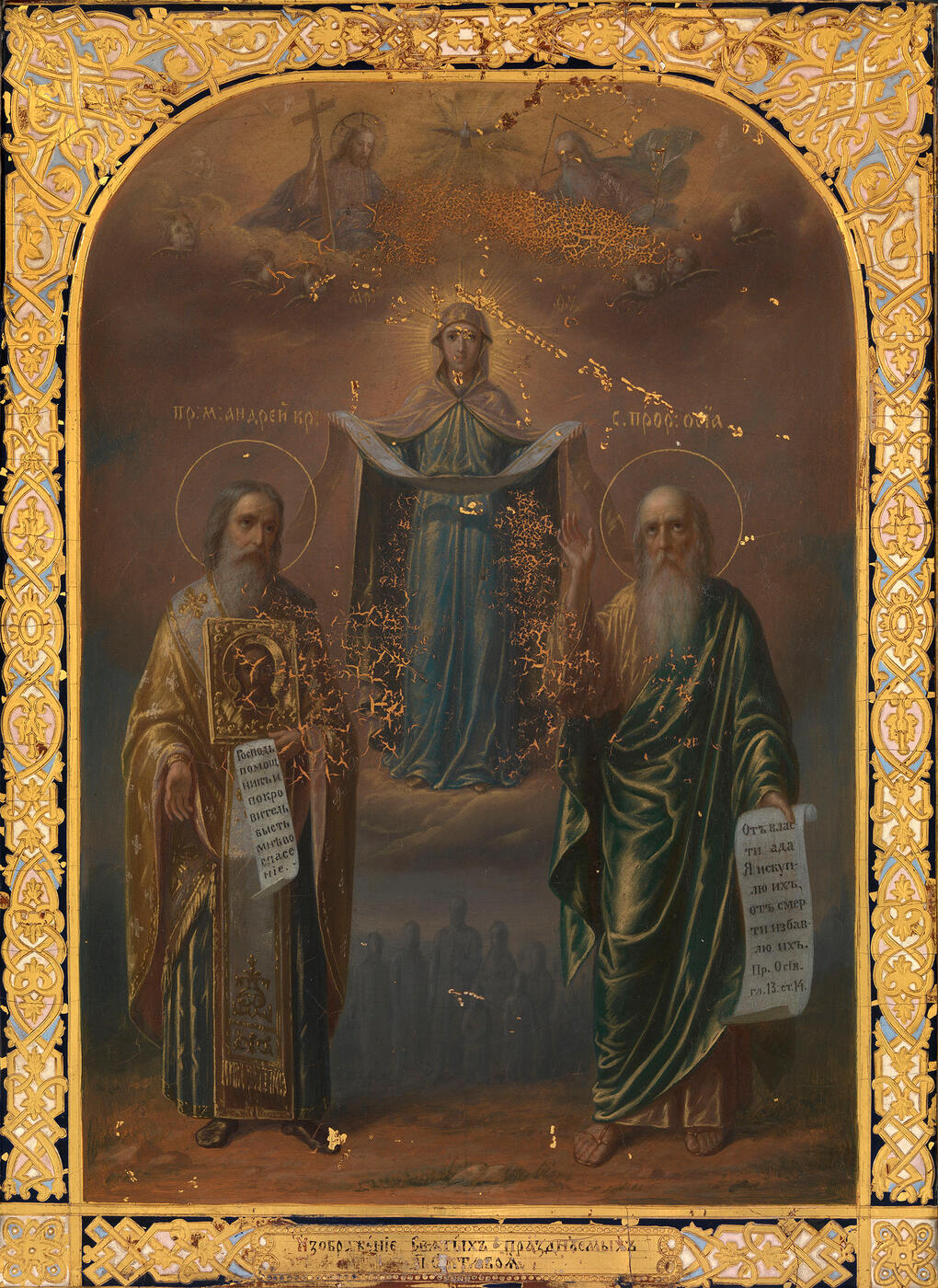5 June 2013 Russian Art Auctions
5 June 2013

608. THE POKROV WITH ST ANDREW OF CRETE AND THE PROPHET HOSEA
1888, FRAME STAMPED WITH THE KIEV PECHERSK LAVRA MARKS IN CYRILLIC, 1885 AND 1886, 84 STANDARD, SILVER PLAQUE FURTHER STAMPED WITH THE KIEV PECHERSK LAVRA MARK, 84 STANDARD.
35 by 26 cm.
40,000–60,000 GBP
Provenance: Sold to the West from the Gatchina Palace and Museum through the All-Union Society Antikvariat in 1928-1934.
Private collection, Europe.
Related Literature: For similar icons dedicated to the 1888 event, see Auction Catalogue, Russian Art, Icons and Works of Art, MacDougall's, 28 November 2012, p. 340, lot 507.
This icon commemorates the occasion when Emperor Alexander III and his family were saved from a train crash on 17th October, 1888. On this day, ten of the fifteen coaches of the Imperial train were derailed close to Borki station, near Kharkov. Sixty eight passengers were injured and twenty one killed. The fact that the entire Imperial family escaped unharmed was regarded as a miracle. The date of 17th October was declared a national holiday; the Holy Synod ordered a Solemn Liturgy and prayers to be offered in every Orthodox church; chapels were built and icons created.
Icons commemorating the events of 17th October 1888 usually depicted the namesake saints of the Tsar’s family members – or the Holy Prophet Hosea and St Andrew of Crete, whose Feast days were jointly celebrated on this date. As distinct from other icons dedicated to the same miracle, our image is composed of symbols. At the centre, the Theotokos holds the Protecting Veil, symbolising miraculous protection for the Imperial family. Above, is the New Testament Trinity and in the foreground are the Venerable Martyr, St. Andrew of Crete and the Prophet Hosea. On the lower border is the inscription: “Depiction of the Saints celebrated on 17th October”. The texts on the scrolls are from the writings of the two holy men and highly appropriate to the miraculous event: on St Andrew’s scroll are the first words from his Great Canon “The Lord has become a help and protector for my salvation” and the verse on Prophet Hosea’s scroll is about the powerlessness of Hell before God and the promise of eternal life: “I will ransom them from the power of hell; I will redeem them from death” (Hosea 13:14). Of further significance is the depiction of the icon of Christ of Edessa held by St. Andrew – a direct reference to the icon that had been on board the train at the time and which became linked to the Imperial miracle.
Our icon is strikingly distinguished by the Tsar’s family depicted in silhouette form in the central background, between the two saints. Despite the sketchiness, seven figures are recognisable: Alexander III (centre), the Empress Maria Feodorovna (right), Grand Duke Georgiy and the Tsarevich Nikolai – the future Nicholas II – (left), Grand Duchess Xenia (extreme right) and the little figures of Grand Duchess Olga and Grand Duke Mikhail (front right). These same characters were depicted on the medal In Commemoration of the Miraculous Deliverance of the Tsar’s Family on 17 October 1888, designed by A. Grilikhis and issued by the St Petersburg mint. A silver memorial plate on the reverse of the icon testifies that it was specifically painted for presentation to Emperor Alexander III: “Earnest offering of the Kiev Pechersk Lavra to the Most Pious Lord Emperor Alexander Alexandrovich III in memory of the miraculous deliverance of His Majesty and his Most August Family from very great danger on the railway 17th October 1888. Platon, Metropolitan of Kiev.” Thus, this icon – aside from its “historical” subject matter – is also connected with one of the oldest and foremost centres of Orthodoxy, the Kiev Pechersk Lavra. To judge by certain artistic characterisitics of the icon, it may have been commissioned in St Petersburg from the famous Peshekhonov Workshop, particularly if its long-standing connections with Kiev are taken into account (in 1843-1853, M.S. Peshekhonov restored frescoes at the St Sophia’s Cathedral, Kiev).
The icon was reproduced by E.I. Fesenko’s Chromolithography in Odessa, 1895. The image caption reads: “A copy of the icon, presented to the Emperor Alexander Alexandrovich III by the Kiev metropolitan Platon in commemoration of the miraculous escape of His Majesty and the august family from the great danger on railway on 17 October 1888”. This plate was included in the Album of Reproductions of Sacred Icons, published by E.I. Fesenko’s Chromolithography in 1897. Repeated reproductions of the present lot are evidence that the icon was considered as a model for prayerful remembrance of the miraculous rescue of the Tsar’s family in 1888.
The icon is a genuinely historic artefact and of special significance in the year when the House of Romanov's quatercentenary is celebrated.
Notes on symbols:
* Indicates 5% Import Duty Charge applies.
Ω Indicates 20% Import Duty Charge applies.
§ Indicates Artist's Resale Right applies.
† Indicates Standard VAT scheme applies, and the rate of 20% VAT will be charged on both hammer price and premium.